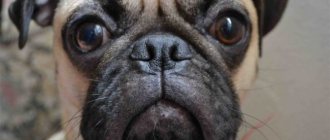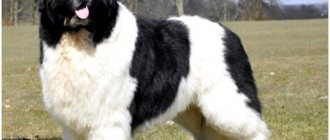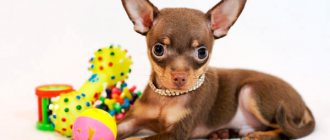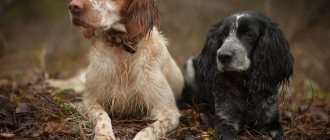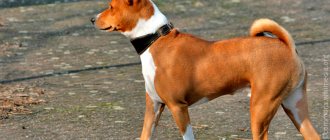Basenji dog - video compilation
You can find many reviews about how Basenji barks. Many happy owners of pets of this breed say that their dogs actually make sounds somewhat similar to barking.
Video - Basenji barking
The information that the dog is silent is not very true. And you can even find videos like this where the Basenji, being sort of a non-barking dog, barks very well. Although, she howls quite well:
Basenji howls like a wolf. It is with this animal that many owners compare the dog. There is a reason for this. The deep and prolonged howl of a Basenji, the video of which is published above, is a sign of the dog’s dissatisfaction, often sadness and loneliness.
The video illustrates very well how the Basenji sings. It's amazing how this sound differs from a howl and conveys the dog's joyful mood. The Basenji's voice is very similar to that of a child.
Video story about the Basenji breed
The video tells in detail about what kind of Basenji breed it is, and what pros and cons there are in the character of the representatives. Graceful and beautiful dogs are great friends and little motivators for an active lifestyle.
In addition to the previous video about the Basenji, the video also gives a general understanding of what awaits the owner who acquires a dog of this breed. Basenjis are favorites of the public, so they can be seen very often at the exhibition today.
Basenji puppies video
Typically, the Basenji breed is not very fertile. There are about 4-6 puppies in the litter. When breeding, it is important to consider that puppies need space in which to grow.
Puppies, of course, are playful and have great energy. Therefore, it is better for owners to hide breakable and torn objects, documents and other important things.
Basenji training
Training a Basenji deserves special attention, because it is a very important component of a dog’s life. How the puppy is raised determines its perception of the world and living creatures in it. Proper training is a guarantee that the pet will have a calm and balanced character without aggression at home and energetic during walks.
On the pages of our website you will find information about dog breeds, treatment for diseases, care recommendations, reviews of ready-made food and feedback on them, as well as much other equally useful and interesting things!
Source
Training
In order for an adult dog to be obedient, it needs to be trained at an early age, from three months. And the first thing you need to teach is to respond to your nickname and obey the commands “Near” and “Come to me.” Jis learn with pleasure , through encouragement and approval. Further, it is very important during walks to wean your pet from the dangerous habit of picking up food and unfamiliar objects from the ground.
The Basenji is a very energetic breed and can be trained and trained during walks in the fresh air. And, most importantly, be patient: do not raise your voice, do not use force. You can punish with a stern look and lack of praise.
History of the origin of the breed
The Basenji breed has several names - African silent dog, "jumping up and down" (local name), Congo terrier, African non-barking dog, bush dog, nyam-nyam terrier, "creature of the bush", gift of the gods.
According to research by scientists, the African dog originated from the areas of Congo, Liberia, Sudan and other areas of Central Africa, where it was highly valued and widely used for hunting.
As gifts to the pharaohs, dogs came to Ancient Egypt, where they were considered a talisman against evil forces and were revered.
Throughout its centuries-old history, this breed has been highly valued for its intelligence, courage, loyalty, unique hunting abilities and ability to remain silent.
The Basenji became widely known after the Craft Exhibition in England in 1937, where the breed was first presented.
In 1941, the first pair of dogs were brought to America.
Nutrition
If you notice that your dog is dividing food into “favorite” and “unloved” foods, know that it is overfed. Reduce the amount of your “favorite” food.
The dog (not the puppy!) eats the entire portion and gains weight. Reduce the amount of food you eat to avoid obesity.
The dog eats the prescribed amount of food, but does not eat if you offer more food or shows signs of satiety. The amount of food will have to be reduced. It would be normal for the dog to eat another bite, since his normal state is to be slightly hungry. An animal should not be allowed to remain in a state of satiety.
Does your dog eat all the food you give him, but at the same time lose weight beyond acceptable limits? The animal does not have enough food, increase its volume!
In a dog with normal weight, the ribs can be easily felt with your fingers, but they are not noticeable during external examination. When the dog is standing, its belly should be tucked up, that is, it should not coincide in diameter with the chest. When viewed from above, the abdominal area just behind the last ribs appears narrower relative to the rib cage.
Description of the Basenji and characteristics of the breed
Everything we know about the Basenji: intelligence, ingenuity, affection for humans, courage, excellent hunting skills, exterior, behavior - are the result of natural selection.
The Basenji is a silent dog that evolved without human intervention. Initially it is a hunting dog.
- A distinctive feature of the African dog is that it does not bark. However, it cannot be said that she is voiceless or mute. This is due to the structure of the vocal cords, the flat thickening on which does not allow barking. Instead of barking, Congo terriers communicate through sounds reminiscent of grumbling, emitting muffled laughter, sighs, snorting, purring, and groans.
- A characteristic sign of excitement and concentration is a wrinkled forehead, like a Shar Pei.
- Basenji is hypoallergenic . She doesn't smell like a dog. Very clean. Washes like a cat .
- "Silent" does not like water. This is due to genetic memory; rivers in Africa are dangerous due to encounters with crocodiles. There is no need to bathe the dog; like a cat, it cleans itself.
- The breed is heat-loving; in winter the pet should be dressed in overalls. At home, the Basenji's place should be warm.
The Congo Terrier is friendly, sensitive to the mood of the owner. Despite its small size, the dog is fearless and strong.
Breed standard
Basenji is a hunting breed, formed in the natural environment, hence the developed muscles, good coordination of movements, high mobility and speed.
- Height 43 cm at the withers and weight 11 kg – males; height 40 cm at the withers and weight 9.5 kg – females.
- A beautifully sculpted head with a slightly flat skull. The cheekbones taper towards the nose, the muzzle is slightly shorter than the length of the skull. Wrinkles form on the forehead if the dog is tense.
- The teeth are straight and tightly set. Full, scissor bite.
- The ears are erect, graceful, pointed, located high with an inclination forward and towards the center of the head.
- Black nose is preferable.
- The eyes are expressive, almond-shaped, dark. The look is smart, attentive.
- The neck is strong, long, widening towards the base. head held high.
- The body is harmoniously developed. The back is short and straight. The stomach is tucked. The chest is round. The loin is short.
- The tail is tightly curled into a ring and lies on the croup, the buttocks protrude beyond the base of the tail.
- The forelimbs are slender with long forearms, the elbows are directed strictly back, the shoulder blades are muscular. The hindquarters are strong, the shins are long, the hocks are parallel. The paws are small with thick pads and short nails.
- The coat is short, lies close to the body, and is soft to the touch.
Breed standards are determined historically by the development and use of the Basenji.
Coat colors
There are four coat colors of the African dog provided for by the standard:
- black and white, or black;
- red-white, or brown-white;
- black and white tan with yellow markings;
- brindle.
We talk in more detail in a separate article about Basenji colors.
Brindle coloring was included in the standard in 2000. The brighter the black stripes, the higher the score.
Owner reviews
Miroslava
My Basenji is almost half a year old. Very well-mannered, calm, chews, like all puppies, everything he finds. The wires have been removed, only what you don’t mind is accessible. When my child was growing up, it was much worse. The child also opened boxes, and the dog is great. No problem. Compared to conventional breeds, it is not for everyone. This is a companion dog - it needs a person. She can't do it alone. Well, mine definitely can’t. I go with him everywhere. This only makes me happy. He sleeps next to him, eats next to him, and is constantly in his arms. Like a little child. For active people who know how to love and have a lot of patience, wisdom and understanding. He won't be an obedient dog. Decorating the sofa too. For that, thanks to him) He will be a friend always and everywhere. Then they took it))) So that the house would not be destroyed - to walk, play, occupy. This is a dog whose brain needs to be busy. Very smart. They are not obedient, that is why they are smart. He will always have his own view on things. Often I listen to him) And sometimes I don’t. And then you need to be a calm leader of the pack, and not run after him with a stick shouting “no” - it’s pointless. He will take revenge and be right. This is probably a dog for cat people. Those who know how to find an approach, calmly explain, and if necessary, be wiser, and not insist on their own.
Galina
Often ready to kill, but not ready to part. I adopted a dog at the age of 2, to be honest, at first I held my head by the head that I took. Now he's a charming dog. Not simple, with its own character, individuality that must be respected..... In order to be the “master” of a Basenji, you need to love him very much and have a lot of time. As for food, mine eats everything, and what it can’t eat it will break off and gobble up and there will be nothing for it... As for the statement that this is not a dog for everyone, but what kind of dog is for everyone??? Having an animal in the house is not for everyone.
Elena
I’ll hang myself, I have a Pomeranian and a Toy, and my son also bought this bedji
Sergey Vladimirovich
Good day, owners and anyone who is looking at this breed. I assure you, any breed of dog without love and patience will be problematic. It’s like kids. unless of course the Dalai Lama)) Having adopted a representative of this breed, the breeder must forget about the immediate readiness of the dog to carry out his command. How about playing? How about lisping? This animal craves variety. Don’t forget, you let a real semi-wild animal into the house (a ferret is not a dog after all)) but they are also kept in apartments and I don’t require him to bring sticks. This sweet face, with its thinker's folds, contented grumbling and skillful waving of a donut (which they themselves forget that they have), when you appear in the evening, more than compensates for all the shortcomings of this cheerful and terribly funny breed. AND SOMEONE IS DREAMING FROM THE SPHINXES)))
Video
Basenji character
The African non-barking dog has a stable psyche, an inquisitive mind, and a cheerful disposition.
Thanks to their high intelligence, Basenjis quickly adapt to any environment and behave confidently, calmly and independently. When at home, the dog is calm and sleeps a lot. During a walk, his behavior changes dramatically; he requires games, a lot of attention, and active movement.
The hunting instincts are so developed that the dog chases everything that moves, it is impossible to catch up with it, so the dog must be on a leash while walking.
The Basenji loves to pick up and eat whatever it wants. You need to carefully monitor this, since it is almost impossible to wean yourself from the habit. The Congo Terrier is very devoted to its owner; a close emotional connection is established between them that lasts a lifetime.
Walks
Basinger the dog leads an active lifestyle. She needs walks and exercise. You need to walk with your pet 2 times a day for 1.5-2 hours. If the pet lives in a private house with a large plot and a high fence, then it can be let out for a walk alone. It is worth using a leash when walking your animal in public places. The pet must walk in any weather. However, due to its thin fur, the dog runs the risk of freezing. For such cases, clothing is suitable. In autumn rainy weather, your pet can be dressed in waterproof overalls, and in the first frosts - a fleece-lined vest.
Basenji on a walk with a leash
Education and training
Due to their independence and natural intelligence, Basenjis are not easy to train. In this process, it is important to limit the pet’s freedom of choice without the use of violence.
One of the main commands, “come to me,” is practiced using a roulette leash.
Release the leash and let the dog move as far away as possible. When the leash ends, give the command “come to me.” Unable to move further away from the owner, the pet will run towards him, you need to reward him, praise him, give him a treat. Commands should be practiced constantly, at different times and under different conditions.
Training and raising a Basenji requires love and patience, and the ability to limit choices without using violence.
Basic principles of education:
- always thank and reward your pet for following commands;
- do not use violence or punishment;
- practice commands constantly;
- The dog should be trained not only individually, but also in a group. She carefully watches and remembers how other group members carry out commands.
From an early age, the dog should be taught that the owner can get into his mouth and get food out of it. This manipulation will help protect the pet if the owner promptly and calmly takes the dirt that he picked up on the street from his mouth.
The dog must eat food in a certain place; do not treat the dog near the table or refrigerator. Then she will climb onto the table and into the refrigerator on her own.
Basenjis require a lot of attention and love; communication with a pet will protect the house from pogroms caused by dogs deprived of attention.
Socialization
The Basenji needs as early socialization as possible, otherwise the pet will grow up timid and fearful. It is important to establish contact with the puppy - education is based on complete trust and mutual understanding. As they grow older, the owner must correctly build a hierarchy - the animal must not be allowed to rule. Unwanted behavior must be stopped immediately.
Basenjis get along with other pets if they have known them since childhood. In relation to small animals, for example, rodents, the dog may exhibit a hunting instinct. Therefore, pets should not be left alone.
A dog and a cat become friends when they are adopted at the same time. It is highly undesirable to adopt a puppy if a feline is already living at home. Most likely, he will be jealous of the owner and begin to offend the baby.
Basenjis and school-aged children become fast friends. They enjoy spending time playing active games. Relationships with babies are somewhat more complicated. The dog will be interested in the new family member, but may accidentally injure the baby. Also, the pet will not tolerate disrespectful treatment - it cannot be pulled by the ears and tail, or disturbed if the animal does not want it.
In order for the Basenji and children to quickly find a common language, teenagers should be told in advance about the rules of behavior with the animal and the dog’s body language.
Care and maintenance
Caring for and maintaining a Basenji does not require much effort.
- Get vaccinated regularly.
- Periodically treat for fleas and parasites.
- Provide adequate nutrition.
- Basenji is thermophilic, the dog’s place in the house should be warm and soft. It can be a soft kennel house, or a voluminous bed.
- In winter, you should wear overalls for walks.
- Walks should be daily, lasting 2 hours, in any weather, with active movement and games.
- The dog should always have a bowl of clean water.
TOP nicknames
The nickname should not only be beautiful, but also easy to remember. Long ones are reluctantly accepted by dogs. The table shows a list of the most popular Basenji nicknames in alphabetical order.
Table - Popular Basenji nicknames
| First letter of nickname | Male | Bitch |
| A | — Akela; — Atila; — Anubis; — Antey | — Agatha; — Aurora; — Assol; — Akira |
| B | — Bard; — Beckham; — B.J. | — Bagheera; — Bonnie; — Barry |
| IN | — Viking; — Veles; — Varyag | — Vesta; - Wendy — Vicki |
| G | — Hector; — Hermes; — Hero | — Hera; — Grace; — Gita |
| D | — Dobie; — Jack; — Dandy | — Dana; — Daisy; — Jane |
| E | — Elisha; — Elson; — Erofey | — Eva; — Elana; - Christmas tree |
| AND | — Jean; — Julian; — Justien | — Jasmine; — Janet; — Julie |
| Z | — Zeus; - Zorgo; —Zerro | — Zara; — Xena; — Zolda |
| AND | — Eli; — Indigo; — Icarus | — Irma; — Ida; — Ilana |
| TO | — Kesk; — Kent; — Chris | — Kira; — Casey; — Kelly |
| L | — Lari; — Lax; — Life | — Laura; — Lana; — Lilith |
| M | — Murphy; — Martin; — Mitch | — Martha; — Mary; — Mila |
| N | — Nick; — Knight; — Norton | — Nessie; — Nori; — Natty |
| ABOUT | — Austin; — Orpheus; — Odysseus | — Audrey; — Ollie; — Omega |
| P | — Pirate; — Prince; — Pongo | — Pandora; — Puma; — Puffy |
| R | — Ray; — Ricky; — Rolf | — Rona; - Rosie — Rachel |
| WITH | - Scooby — Skif; — Silver | — Cindy; - Sally — Sparta |
| T | — Thor; — Tim; — Twix | — Tiffany; — Tori; — Tilda |
| U | — Uranus; — Ulf; — Ujer | - Ulma; - Delight; — Ulma |
| F | — Fred; — Flint; — Faust | — Frida; — Fabi; — Fortuna |
| X | — Hulk; — Hugo; — Harty | — Hannah; — Helga; —Haley |
| C | — Cyclone; — Cezzi; — Cent | — Tsara; — Cessa; — Tserona |
| H | — Chester; — Chips; — Cheater | - Cherry; - Chana; — Chelita |
| Sh | — Sherlock; — Shepard; —Shakespeare | — Shelley; — Shakira; — Cher |
| E | — Eddie; — Ernie; — Angel | — Emmy; - Eureka; — Amber |
| YU | - Yukki; - Cabin boy | — Yuji; — Juno; — Yula |
| I | — Jason; — Yakhont; — Yard | — Yasmin; — Yanni; —Yaki |
How long do Basenjis live and their health?
With proper care, nutrition and regular medical monitoring, the life expectancy of an African non-barking dog at home will be 12 – 16 years.
This breed is distinguished by good health and immunity, but, like any living creature, it is susceptible to diseases:
- Progressive retinal atrophy. The disease is genetic and manifests itself in adulthood.
- Digestive disorders, poisoning. This is due to the habit of eating garbage on the street and a poor diet.
- Hypothyroidism. Insufficient thyroid function manifests itself in the form of obesity, swelling of the paws and face, and poor condition of the skin and coat.
- Fanconi syndrome. This kidney disease appears between the ages of 5 and 7 years. Expressed in weight loss, frequent urination. If left untreated, the dog dies. The causes of the disease have not yet been established. But it is known that it is transmitted at the genetic level.
Regular visits to the veterinarian will help identify diseases and successfully treat your pet.
The vaccination and deworming schedule should be strictly followed.
Breeding
Girls come into heat at the age of 7-8 months. It is noteworthy that in this breed it occurs only once a year: in the autumn-winter period. Therefore, the easiest time to buy a puppy is in the spring. Dogs are bred when they reach the age of one and a half years.
Mating is planned in advance. Both parents are prepared for it: they check their health, feed them a balanced protein diet, and introduce them to each other.
The female's pregnancy lasts 56-73 days. Signs of pregnancy appear towards the end of the first month. These include pet lethargy, drowsiness, but good appetite. Be sure to feed your dog high-quality food that is rich in vitamins and minerals.
Ensure that a veterinarian is present at the birth. Especially if they are the first. A specialist will help in case of unforeseen circumstances.
Normally, 2-3 puppies are born. Although there have been cases when 10 babies were born at one time.
How to choose a puppy and how much does a Basenji cost?
The African Non-Barking Dog is a rare breed, so when purchasing a puppy you must contact the breeder directly (individual or kennel). You should not hope that you can buy a Basenji puppy at the bird market.
Puppies are purchased from the age of two months. Before this, you should equip a place at home for the dog and buy toys.
When choosing, pay attention to:
- for bite;
- mouth color (pink sky);
- cleanliness of mucous membranes, ears, eyes, nose;
- fatness;
- activity.
A healthy puppy is strong, active, curious, not shy.
You should pay attention to the parents, they should be well-groomed and calm.
The breeder must provide a veterinary passport and a puppy card for the puppy. The results of the examination for dysplasia must be recorded in the veterinary passport. When purchasing, you can ask all your questions and in the future maintain contact with the breeder to exchange experiences.
Prices for Basenji puppies depend on the class of the puppy:
- Pet-class puppies have deviations from the standards and cannot participate in exhibitions, but they are healthy and can become pets. The cost of a puppy ranges from 15 to 20 thousand rubles. It all depends on the level of deviations, the pedigree of the parents;
- Pedigree show-class puppies meet all breed standards, can participate in exhibitions and produce offspring. Price from 30 to 60 thousand rubles and above.
Prices are in the middle segment. The choice depends on the purpose and capabilities of the future owner.
On the Internet, puppies of this breed are offered at prices ranging from 5 to 11 thousand rubles .
Important! You can be deceived and buy something that is not a Basenji at all.
What to feed?
An important rule of feeding Basenji dogs is not to overfeed. The dog should feel light and free, not become skinny, but there is no need for excess fatness. The ribs are an indicator of the pet’s fatness; if the bones stick out, the dog is hungry and extremely thin; if they are covered with a layer of fat and cannot be touched, the pet will need to be put on a diet. Think in advance about what to feed your Basenji.
The choice between dry food or natural food is the choice of every breeder. The first option is allowed exclusively either super premium class or premium class. It is highly not recommended to use cheap and low-quality feed. Natural food is prepared in a balanced manner so that the dog receives the necessary substances and vitamins.
The diet contains:
- Raw meat is not fatty: veal and beef. An adult dog receives 1/3-1/2 of the daily meat ration per day.
- Cereals are an essential component of a dog’s diet.
- Vegetables are good for you.
- Choose fruits that are not sour only.
- It is supposed to give greens.
- Oils help maintain good skin.
- Eggs are boiled soft-boiled and given no more than once a week.
- Fermented milk products. Basenji puppies are certainly fed fermented milk products in the morning.
- Pure water.
Kinds
The Basenji dog breed is divided into 2 types: plain and forest.
Individuals of the first species are large, their height at the withers is 40 cm. The color of the dog’s coat is brown and white. These dogs have a so-called “collar” that slopes slightly down to their chest.
Forest dogs are small in stature - less than 40 cm. They are characterized by dark eyes and fur. This species is often called pygmy dogs.
In combination with white color, the standard designates 6 color types of the Basenji breed:
- black;
- brown;
- ginger;
- brindle;
- tricolor (black and white with tan markings and mask).
There are individuals in this breed with a uniform resin color.
The popular brindle color of the Basenji was only approved in 2000.


